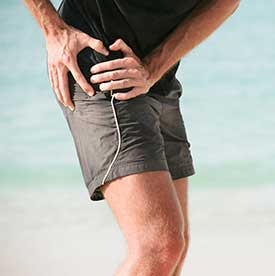Gluteus Medius Tear Treatment in Seabrook, TX

The gluteus medius is an important muscle in your body as it is what allows for the side-to-side movement of your leg. If your gluteus medius muscle becomes injured it can make walking very difficult. Gluteus medius tears are common in runners and may take weeks to heal completely. If you play high impact sports such as soccer or basketball you might also find yourself with a gluteus medius tear. The speed at which a tear is identified will impact the length of the healing process and the course of treatment needed to completely heal the injured muscle.
Symptoms of a Gluteus Medius Tear
Typically, there is no cause or single incident of trauma that directly correlates to a gluteus medius tear. Common symptoms for gluteus medius tears involve pain and tenderness to the outside of the hip. The more that you continue to use your gluteus medius muscle through activities such as walking around your home, climbing stairs, or even just lying on your injured side, will inflict pain from the outside of the hip all the way to the buttock.
Other symptoms of a gluteus medius tear include:
- Weakness when lifting leg or stepping to the side
- Difficulty supporting weight on leg
- Limping
Gluteus Medius Tear Diagnosis
If you are experiencing the symptoms mentioned above, a healthcare provider will assess you through a physical examination. In the examination you will be asked to lie on the unaffected side while the healthcare practitioner abducts the leg against active resistance. Other simple tests may include single leg squats as well as a gait inspection.
If your healthcare provider suspects you may have a gluteus medius tear, an MRI scan is often recommended to confirm the diagnosis and to review the extent of the injury.
Gluteus Medius Tear Treatment
Depending upon the extent of the gluteus medius tear, many at-home treatments can provide substantial relief, helping to slowly heal the tear. Resting the injured muscle and applying ice for short intervals several times a day can help to reduce the inflammation. It is also suggested to elevate your legs and lie in a comfortable position while refraining from high impact activities such as running or other physical activity. Other helpful non-surgical treatments include:
- Cortisone injections
- Anti-inflammatory medication
- Physical therapy
For larger tears and for tears that do not respond well to non-surgical treatments, hip arthroscopy is a popular surgical option. Thin cameras and instruments are used through small incisions made in the skin. Anchors and sutures tie the muscle back down to the bone to restore strength and function to the hip area.
Request more information about Gluteus Medius Tears today. Call (281) 481-2649 or contact Dr. David Vanderweide online.
David G. Vanderweide MD, PA
Address
333 N Texas AveSuite 2000
Webster, TX 77598
(281) 481-2649
www.dvanderweide.com


